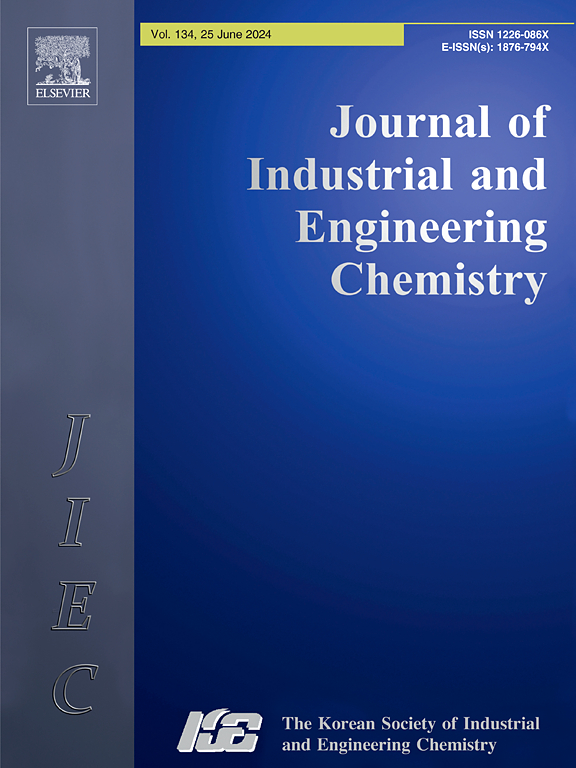用PVA裁剪聚合物电解质,以改善电双层电容器的性能
IF 5.9
3区 工程技术
Q1 CHEMISTRY, MULTIDISCIPLINARY
Journal of Industrial and Engineering Chemistry
Pub Date : 2024-11-19
DOI:10.1016/j.jiec.2024.11.035
引用次数: 0
摘要
这项研究通过溶液浇铸法合成了固体聚合物电解质(SPEs),采用聚乙烯醇(PVA)作为聚合物宿主,硫氰酸钠(NaSCN)作为离子传输媒介。其中还加入了甘油以增强离子传导。傅立叶变换红外光谱分析结果表明,甘油能离解更多的盐。与 SCN 阴离子相关的波段强度降低并变宽。离子传导性是通过电化学阻抗光谱(EIS)测定的。ε'值大约是ε''值的两倍,这在科学界引起了巨大争议。交流电导率光谱显示了不同的区域,这些区域与电极极化和直流电导率的贡献有关。利用转移数测量法(TNM)确定了离子分数及其贡献率,离子贡献率达到 0.93。电解质的电化学稳定性高达 2.67 V。CV 测量结果表明,在电极-电解质界面上没有观察到通过法拉第过程进行的电荷转移。电静电荷-放电(GCD)图的三角形支持电容行为而非氧化还原反应,比电容为 40F/g。据估计,双电层电容器(EDLC)在 1,500 次循环中的常规功率密度和能量密度分别为 1255.2 W/kg 和 5.5 Wh/kg。本文章由计算机程序翻译,如有差异,请以英文原文为准。

Tailoring polymer electrolytes with PVA for improved performance in electrical double layer capacitors
In this work, solid polymer electrolytes (SPEs) were synthesized through solution casting, employing polyvinyl alcohol (PVA) as polymer hosts and sodium thiocyanate (NaSCN) for ion transport. Glycerol was incorporated to enhance ionic conduction. The conducted FTIR results establish that glycerol can dissociate more salts. The band associated with SCN anion decreased in intensity and broadened. The ionic conductivity was determined through electrochemical impedance spectroscopy (EIS). The value of ε’ is about twice that of ε’’ value, which is the subject of enormous scientific debate. The AC conductivity spectrum reveals dissimilar regions endorsed to the contributions of electrode polarization and DC conductivity. The ion fraction and its contributions were determined using transference number measurement (TNM), with ion contributions reaching 0.93. The electrolyte exhibited electrochemical stability up to 2.67 V. Charge transfer via Faradaic processes was not observed at the electrode–electrolyte interface, as indicated by CV measurements. The triangular shape of the galvanostatic charge–discharge (GCD) diagram supports capacitive behavior rather than redox reactions, with a specific capacitance of 40F/g. The regular power and energy densities of the electric double-layer capacitors (EDLCs) were estimated as 1255.2 W/kg and 5.5 Wh/kg, respectively, over 1,500 cycles.
求助全文
通过发布文献求助,成功后即可免费获取论文全文。
去求助
来源期刊
CiteScore
10.40
自引率
6.60%
发文量
639
审稿时长
29 days
期刊介绍:
Journal of Industrial and Engineering Chemistry is published monthly in English by the Korean Society of Industrial and Engineering Chemistry. JIEC brings together multidisciplinary interests in one journal and is to disseminate information on all aspects of research and development in industrial and engineering chemistry. Contributions in the form of research articles, short communications, notes and reviews are considered for publication. The editors welcome original contributions that have not been and are not to be published elsewhere. Instruction to authors and a manuscript submissions form are printed at the end of each issue. Bulk reprints of individual articles can be ordered. This publication is partially supported by Korea Research Foundation and the Korean Federation of Science and Technology Societies.

 求助内容:
求助内容: 应助结果提醒方式:
应助结果提醒方式:


